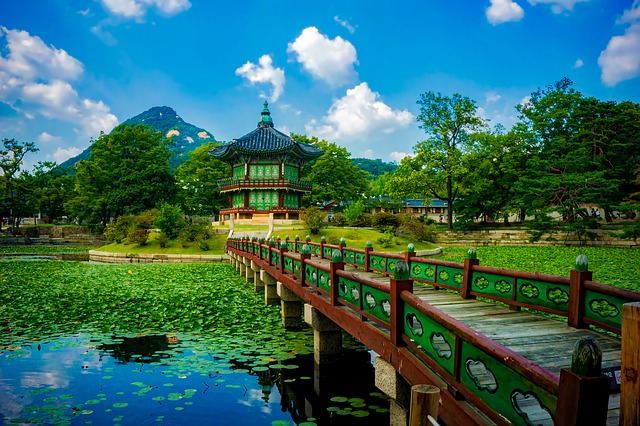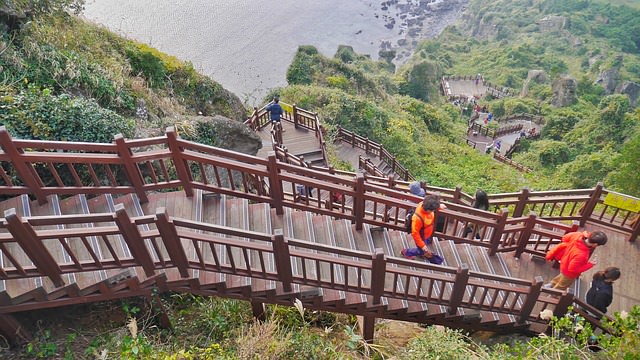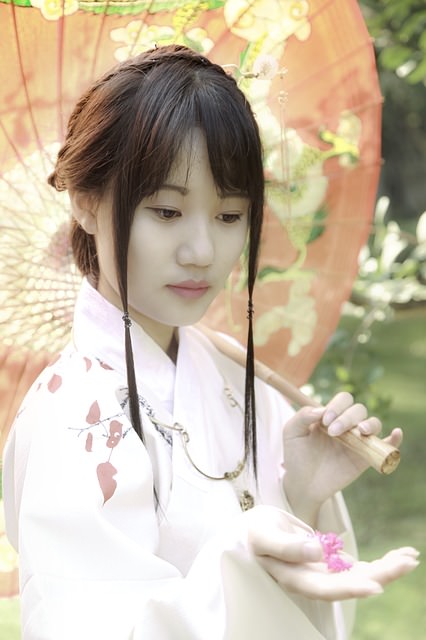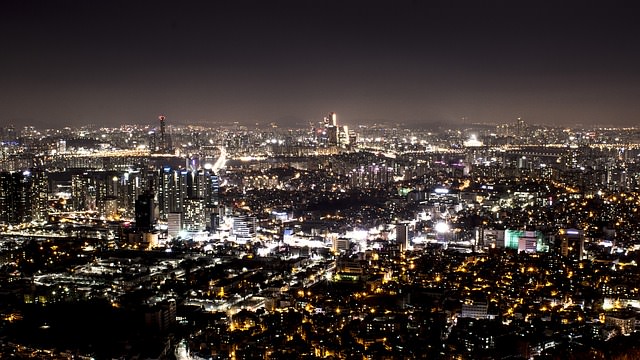Backpacking in South Korea
Travelling in South Korea means discovering only part of the Korean peninsula. Unfortunately, due to political differences, the much larger northern part is only accessible to very few people. However, the dictatorial North has little in common with consumer-oriented South Korea – at least in terms of social conditions.
If you travel through Korea, you will notice little difference from Western countries. Everything runs relatively perfectly, prices are high and there is good medical care. Of course, this also has its disadvantages. The prices have already been mentioned. South Korea is more expensive than the rest of Asia, with the exception of Japan. But despite the perfect infrastructure, there are few travellers and even fewer backpackers to the “Land of Morning Silence”, as the country is often called.

Backpacking in South Korea – Gyeongbokgung Palast
And there is a lot to see and experience there. Fascinating landscapes, the relics of five thousand years of history, to which numerous UNESCO world culture and world heritage belong, as well as the cultural and social combination of a unique link between Japanese and Chinese culture. The negative sides are mass consumption on an almost unknown scale. Travelling in South Korea is easy on land, at sea and in the air thanks to an optimised transport infrastructure, even if it is not always cheap to get from A to B. But as a European, you are a European.
But as a European you are used to it. The cultural, economic and spiritual centre is the capital Seoul, where at least 11 million people live. The rest of the country then has the remaining 38 million inhabitants. During your backpacking tour through South Korea, you will encounter a moderate climate, which, however, is already subtropical in the very south. You can get money easily at the many ATM machines.
But beware, many of the cash machines do not accept foreign credit cards. So look around for machines from Shinhan or Jeju Bank Korea. You can find them everywhere. Talking to the Koreans in their native language or even learning it on a short backpacker trip will be impossible for most travellers. The language is simply too complicated. But you won’t starve to death, because where you go and stand, there’s certainly a food stall or other places to eat nearby. You can eat like the locals with the chopsticks.
Culture in South Korea
South Korean culture is dominated by shamanism, Buddhism, Confucianism and other religious subgroups, as well as by increasing religious disaffection. Perhaps this is the reason why the suicide rate in South Korea is the highest among all OECD countries. Koreans are also known to be quite racist. It won’t be easy for a white person to get into a local dance bar. There are no anti-racism laws.
But you surely travel through the country on your backpacker trip. Even for women travelling alone it’s no problem to walk through the streets at night – this doesn’t mean the red light districts. You can supply yourself around the clock. Even small shops in the city and in the country have been open for a long time. The culture of Koreans is trading. You can haggle anywhere except in department stores. At the local markets, that’s even part of the good manners.

Backpacking in South Korea – Hiking
Backpacker Route in South Korea
When travelling through the country, as a backpacker you can enjoy a culturally and geographically diverse Asian country. Over 70% are mountainous. You can climb the highest mountain of South Korea, the volcano Hallasan with 1950 meters on the island Jeju-do, or swim in the sea on the many offshore islands. Also on the mainland there is a rather high mountain. The Jirisan in the south reaches 1915 meters. No less high is the Seoraksan with 1708 m.
Trekking is possible in the Taebaek mountains. But there is not so much water – at least not sweet water. The country has only 4 bigger rivers. There are no bigger lakes at all. South Korea is by the way also an earthquake region, however with 20 earthquakes per year much less are measured than in the neighboring countries. What should you have seen during your backpacking trip?
Route 1: The classic (15-20 days)
- 3 days exploring Seoul, the cosmopolitan capital of the country. Pure shopping is the order of the day
- 2 days Busan. Also in the second biggest city of the country there is a lot going on.
- 2 days discover a lot of tradition in Daegu
- 2 days exploring Daejeon in Chungnam province.
- 2 days museum tour through Jeonju
- 2-3 days comb through the largest, oldest and most interesting national park Jirisan
- 1 day in the Buddhist retreat Guinsa
- 1 day Panmunjeom see border between north and south
- 1 day visiting Ulleungdo Island
Route 2: Backpacker Intensive Trip (up to 40 days and more)
- 3 days exploring Seoul, the cosmopolitan capital of the country. Pure shopping is the order of the day
- 2 days Busan. Also in the second biggest city of the country there is a lot going on.
- 2 days discover a lot of tradition in Daegu
- 2 days exploring Daejeon in Chungnam province.
- 2 days museum tour through Jeonju
- 2-3 days comb through the largest, oldest and most interesting national park Jirisan
- 1 day in the Buddhist retreat Guinsa
- 1 day Panmunjeom see border between north and south
- 1 day visiting Ulleungdo Island
- 1 day on Jeju Island see bizarre volcanic rock world
- 1 day rice terraces in Darangee
- 2 days exploring Upo swamps by boat
- 3 -4 days climbing Gongryong mountain world
- 1 day fantastic lake hiking trail Uleung Island Seaside Road
- 1 day visit one of the oldest Buddhist temples in the world, Haeinsa Temple
- 2 days tea fields in Boseong
- 2 Days Landscape Photography in Seryang-Je
- 2 days scenic region of the Poppy Garden in the Simhak Mountains in Paju
Travel times in South Korea
The relief of South Korea doesn’t reach very high into the sky, but there are still mountains of almost 2000 m height. And not only up there it can get really cold in winter. South Korea is surrounded by the sea from three sides. But only in the extreme south there are subtropical climatic conditions. In the summers it gets bulgily hot and in the winters very cold. The country’s weather formula is that simple. There is snow as well as frost. Warm dressing is therefore already announced in the autumn months. Those who are tough can visit the country all year round. As always: There is no bad weather, there are only bad clothes.
Backpacker Budget in South Korea
Traveling and living in South Korea is a bit more expensive compared to some neighboring backpacker countries in Southern Asia, but not as expensive as in Western Europe, Japan or North America. You can usually expect to make ends meet with a budget of 30 to 50 euros a day. The longer you stay, the cheaper your stay will be.
The local currency is the won. The currency is relatively stable thanks to the high economic performance of the country and is only subject to minor exchange rate fluctuations. A simple meal in a small restaurant costs around 5 euros. The higher the class, the more expensive. But that’s nothing new. Those who like McDonald pay 4 Euros for a combo.
The local beer costs around 2.5 euros – half a litre. In the bars this can quickly become much more. Imported beer also costs twice as much. And although the Koreans are coffee addicts, you don’t get them thrown in. For a Coke you have to plan 1,3 Euro (0,3l). Bottled water costs one third.
Public transportation in South Korea
Travelling in local buses is quite inexpensive. A single ticket costs around 1 Euro in the city. Those who stay longer in Seoul should buy a monthly pass. For 40 Euro you can drive unlimited. Taxi driving is by far cheaper than in Germany. The starting rate is 2.5 euros, each additional kilometre costs a little less than one euro more. The petrol in South Korea with 1,4 Euro per litre is also not cheap.
Bus driving
Buses run all over the country. But if you want to make fast progress, make sure you take the direct buses or the Express or Intercity buses. If you don’t use these types of buses, a trip of 120 kilometres can take almost three hours. The best way to find out the prices for a long-distance bus trip in South Korea is to check out the homepage of Kobus – Attention!!! Most Korean buses do not have an on-board toilet.
Domestic fares in South Korea
Flying is not worthwhile for backpackers because of the small dimensions of the country. If you still want to do it, check out the websites of the airlines Korean Air, Hansung Airlines and Jeju Air. Some flights are even said to be cheaper than express trains. It’s worth comparing.
Rail travel in South Korea
A good and safe option for backpacking through the country is the train. The few but well developed railway lines are operated by the company KORAIL. You can ride with slow and high speed trains. With the KTX speed trains it goes much faster, but costs also more. The express trains run between the capital and Busan, and from Seoul to Mokpo. You can find out what the train ride costs on the homepage.
Backpacker accommodation in South Korea
South Korea is not a cheap travel destination and this is also reflected in the accommodation offers. Although there are all kinds of overnight accommodations that you can take advantage of on your backpacker trip, they cost a lot. Those who prefer it very cheap will take a bed in a simple hostel, which is comparable to German youth hostels in terms of prices.
But South Korea has alternatives. An overnight stay in a 5-star hotel can easily cost from 100 euros upwards. Outside the season, even the best hostels are often inexpensive. But there are also hostels where you can lie on mattresses directly on the floor. Underfloor heating is included. How much does it cost to spend the night backpacking in South Korea? A look at the Hostelworld hostel page will give you some information. Accordingly, the prices for a bed in a hostel are as follows:
- Seoul 14 -17 Euro
- Busan 16 Euro
- Jeju Island 15 Euro
- Gyeong-ju 12 Euro
- Sokcho 17 Euro
- Daegu 18 Euro
- Incheon 8 Euro
- Jeonju 17 Euro
- Gwangju 15 Euro
The prices in the hostels partly vary considerably, even within the hostel. For a double room you can easily triple the price. Motels are already a cheaper alternative.
Motels on exit roads and motorways
Motels are an alternative if you are looking for an overnight option. Even if you are not travelling by rental car. The motels are also often used as love nests, without putting buyable love in the foreground. For 24 Euro you get a double room with TV, private bathroom and PC connection. You can find most of the houses at the entrance and exit roads to cities or motorways.
Minbak in the country
In the rural region of South Korea you also know the so-called minbak. These are rooms in private houses. Searching for accommodation in private houses is quite common in South Korea, also for the locals. You will then be accommodated in Ondol rooms. These are the already mentioned mattress rooms with heating. Bathroom and toilet are shared.
For 15 Euro you can get a bed in a minbak out of season. Not much different are the private accommodations, which do not fall into the minbak category. These are usually found close to major attractions. A budget alternative is to stay in a public bathhouse, the so-called Jjimjilbang.
You can’t stay overnight, but for little money you can bathe all day, sauna and relax. There are also top houses of this kind with private rooms, TV, video and more. But then they cost more. You can even stay in different temple complexes. Asking costs nothing. Camping is only allowed on designated sites.
Backpacker Trips, Tips & Highlights in Südkorea
Travelling the country is one thing, getting to know Korean culture is another. You have to be prepared for something new in your dealings with Koreans. That’s respect for old age. An older Korean may ask you about your status, your life, and your education. You should answer these questions.
You’ll also notice that the locals bow to the elders and higher social ranked people. Greeting is done with two hands and not with one. Above all, leave the bloody story as a topic off the table. The Koreans are a homogenous and proud people. Which isn’t always good. Because Koreans are usually damn racist.

Japana, Suedkorea oder Sued Korea?
Backpacker Highlights in South Korea
One of the backpacker highlights in South Korea is shopping. Especially in the capital Seoul you might go crazy with the offer of technical goods. Also try a delicious ginseng tea. It gets tired spirits back on their feet. It is also available as wine. Just like you will always meet ginseng again. The Koreans heal everything with the root. And it’s supposed to age, too. That doesn’t seem exaggerated, because the country has one of the highest life expectancies.
Look around for jade products and handmade textiles on the markets. One place to satisfy the shopping craze backpacking in Seoul is Mok dong Rodeo Street. If you’re looking for antiques, you’ll have to go to the Jangangpyeong market. To make shopping a little cheaper, check out the Tax Free Shopping Centers. If you want to experience Korean lifestyle in its most original form, go to a public bath in Jjimjilbang. Sauna, massage, relax – everything is included.
Backpacker insider tips in South Korea
To take a look at Seoul from the outside, take a boat to Youido Island. You will then land at the Korean world trade center. You will discover old Korea in the museum village Yang Dong not far from Suwon. There the people live according to the ancient traditions. In the mountains of Kyongju you will find the oldest known observatory in the world.
The lively and original Korea of today awaits you at the Chagalchi Fish Market in the town of Pusan. When you reach the small town of Namwon, on the Chiri Mountains, you really think you’re in Switzerland. As in past times, you’ll cross the narrow wooden bridge on the Namdae River in Muju. Probably the most visually impressive mountain in Korea is Ulsan Rock, in the Seorak Mountains. The mountain has six peaks.
Certainly not the biggest temple is the Yongam Temple, but nowhere else in the world will you have such a view of the mountains from a temple complex. The temple is partly situated above the clouds and offers a fantastic view to the Geumgang Mountains. You should already be free of vertigo when you cross the freely hanging suspension bridge in the Daedun Mountains at Imgeum Rock. It’s more than 80 meters downhill.

Backpacking in South Korea – City Life
Food & Drinks in South Korea
As in many Asian countries, your backpacker journey through South Korea is not just about fascinating geography and cultural diversity. You will also discover new taste adventures. However, Korean cuisine no longer has much in common with the popular Southeast Asian cuisine. Although rice is also an important part of meals here, soup is in the foreground of many Korean dishes and menus. However, in the rarest cases it is a matter of light broths, but often a strong food. She does not eat the soups with the chopsticks. But knives and forks are still served on request.
Food in South Korea
Since it gets really cold in Korea with snow and ice, fresh vegetables are not available all year round. The Koreans therefore fermented the vegetables. In Korea, seafood and algae are often eaten. In most cases the sauce is based on soy sauce, which is called ganjang in the local language.
The many different table labels that you should know if you should ever be invited are exciting. Never blow your nose, cough or sneeze while eating. Then you’ll also have to wait until the table elder starts eating. Never grab anything with your hand. And certainly not with the left one. Please don’t make any other noises apart from sipping. If you start looking for the icing on the cake in your meal, you’re through with your host.
You should try the traditional meat dish Bulgogi. The paella is similar to the haemultang. If you get Hoe, you eat raw fish. But it is pot-fresh and spicy. Bibimbap is simple and delicious. This is simply rice with vegetables and an egg on top. Backpacker pure food. Of course, you will find the famous fast food chains in all major cities. Also local fast food shops are gladly visited by the city Koreans.
Drinking in South Korea
The Korean also likes to take one to his chest. However, the main drink next to the water is tea. In Korea, tea grows in the mountains. The yuja fruit found in the country is the basis for the tea of the same name. It is then sweetened with honey or syrup. Drinks are also brewed from rice. There is beer only since approximately 80 years in the country, however, beer is the racer under the alcoholic beverages with the Koreans. By the way, beer is called Maekju. If you are offered a nongju, then it is a milky rice wine. But you should know that in Korea you never drink alcohol without a few snacks.
Backpacker Visa und vaccinations in South Korea
You don’t need a visa for your backpacker trip through South Korea. German citizens can enter as tourists up to 90 days without a visa. Nevertheless you need valid entry documents. According to the Federal Foreign Office, the entry regulations are as follows:
- Passport: Yes
- Provisional passport: Yes
- Identity card: No
- Temporary identity card: No
- Passport for children: Yes, with photograph
- Still valid child ID according to old: Yes, with photo
Important for backpacker family with child
Children’s entries in a parent’s passport are no longer valid. All children need their own identification document to enter South Korea. If you want to stay longer than three months in the country, you have to apply for a visa at the foreign mission. The same document must be presented when entering and leaving the country.
Medical information for South Korea
You can enter the country without a vaccination, but it is advisable to have the standard vaccinations of the Robert Koch Institute up to date. Malaria is hardly known, but can occur in summer. Tsutsugamushi fever can become a problem when trekking in the country in summer. In any case, you will benefit from optimal medical care.
